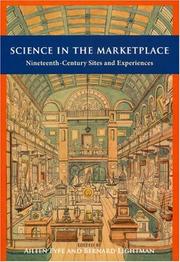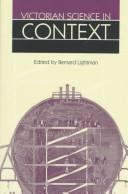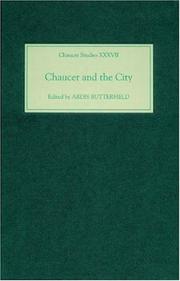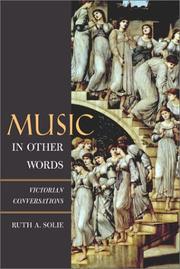| Listing 1 - 10 of 12 | << page >> |
Sort by
|

ISBN: 022615002X 9780226150024 9780226276502 0226276503 Year: 2007 Publisher: Chicago : University of Chicago Press,
Abstract | Keywords | Export | Availability | Bookmark
 Loading...
Loading...Choose an application
- Reference Manager
- EndNote
- RefWorks (Direct export to RefWorks)
The nineteenth century was an age of transformation in science, when scientists were rewarded for their startling new discoveries with increased social status and authority. But it was also a time when ordinary people from across the social spectrum were given the opportunity to participate in science, for education, entertainment, or both. In Victorian Britain science could be encountered in myriad forms and in countless locations: in panoramic shows, exhibitions, and galleries; in city museums and country houses; in popular lectures; and even in domestic conversations that revolved around t
Science --- Science museums --- Science centers --- Museums --- Natural science --- Natural sciences --- Science of science --- Sciences --- Social aspects --- History --- Great Britain --- Intellectual life --- 19th century, history, historical, humanities, science, transformation, change, scientists, marketplace, social status, authority, discovery, education, entertainment, victorian period, britain, british, panoramic shows, exhibitions, galleries, museums, lectures, cultural studies, culture, popular sciences, common points of discussion, phrenology, popularity, natural, nature, electricity, anatomy, demonstrations.
Book
ISBN: 1784997447 9781784997441 9781784997885 1784997889 9781784992606 1784992607 Year: 2016 Publisher: Manchester [England] : Baltimore, Md. : Manchester University Press, Project MUSE,
Abstract | Keywords | Export | Availability | Bookmark
 Loading...
Loading...Choose an application
- Reference Manager
- EndNote
- RefWorks (Direct export to RefWorks)
This book explores the legal and social consequences of growing up illegitimate in England and Wales. Unlike most other studies of illegitimacy, Frost's book concentrates on the late-Victorian period and the early twentieth century, and takes the child's point of view rather than that of the mother or of 'child-saving' groups. Doing so allows for an extended analysis of criminal and civil cases involving illegitimacy, including less-studied aspects such as affiliation suits, the poor law and war pensions. In addition, the book explores the role of blended, extended and adoptive families, the circulation of children through different homes and institutions, and the prejudices children endured in school, work and home. While showing how the effects of illegitimacy varied both by class and gender, the book highlights the ways in which children showed resilience in surviving the various types of discrimination common in this period. It will appeal to anyone interested in British social history, childhood studies, or legal history.
Illegitimate children --- Bastard children --- Children of unmarried mothers --- Children --- Illegitimacy --- Unmarried mothers --- Social conditions --- Legal status, laws, etc. --- History --- England. --- Victorian children. --- Wales. --- affiliation suits. --- bastardy laws. --- child circulation. --- child-saving groups. --- criminal courts. --- fostering. --- gender. --- illegitimacy. --- late-Victorian period. --- legitimacy. --- married parents. --- non-maternal defendants. --- poor law. --- social discrimination. --- unwanted children. --- war pensions.

ISBN: 1283058391 9786613058393 0226481107 9780226481104 9781283058391 6613058394 0226481115 9780226481111 0226481123 9780226481128 Year: 1997 Publisher: Chicago, Ill. : University of Chicago Press,
Abstract | Keywords | Export | Availability | Bookmark
 Loading...
Loading...Choose an application
- Reference Manager
- EndNote
- RefWorks (Direct export to RefWorks)
Victorians were fascinated by the flood of strange new worlds that science was opening to them. Exotic plants and animals poured into London from all corners of the Empire, while revolutionary theories such as the radical idea that humans might be descended from apes drew crowds to heated debates. Men and women of all social classes avidly collected scientific specimens for display in their homes and devoured literature about science and its practitioners. Victorian Science in Context captures the essence of this fascination, charting the many ways in which science influenced and was influenced by the larger Victorian culture. Contributions from leading scholars in history, literature, and the history of science explore questions such as: What did science mean to the Victorians? For whom was Victorian science written? What ideological messages did it convey? The contributors show how practical concerns interacted with contextual issues to mold Victorian science-which in turn shaped much of the relationship between modern science and culture.
Science --- History --- Great Britain --- Social conditions --- victorianism, victorian period, science, scientific studies, scientists, humanities, fascination, engagement, cultural study, culture, ideology, ideological approach, great britain, british history, historical contexts, 19th century, social conditions, knowledge, economics, biology, biological, politics, political, charles darwin, evolution, darwinism, satire, literature, race, fiction, literary, representation, working environments, zoology, empire, colonialism.
Book
ISBN: 1526129760 9781526129765 Year: 2018 Publisher: Baltimore, Maryland : Baltimore, Md. : Project Muse, Project MUSE,
Abstract | Keywords | Export | Availability | Bookmark
 Loading...
Loading...Choose an application
- Reference Manager
- EndNote
- RefWorks (Direct export to RefWorks)
Drawing on an eclectic range of primary and secondary sources Chaplin examines the development of darts in the context of English society in the early twentieth century. He reveals how darts was transformed during the interwar years to become one of the most popular recreations in England, not just amongst working class men and, to a lesser extent, working class women but even (to some extent) among the middle and upper classes. This book assesses the social, economic and cultural forces behind this transformation. This work also considers the growth of the darts manufacturing industry and assesses the overall effect the growing popularity of darts had on interwar society and popular culture, with particular reference to the changing culture and form of the English public house. This original study will be of interest to sports historians, social historians, business historians, sociologists and sports scientists.
Darts (Game) --- Social aspects --- History --- English pub. --- English public house. --- English society. --- National Darts Association. --- Victorian period. --- brewing industry. --- dartboards. --- darts manufacturing industry. --- darts. --- interwar society. --- mass leisure. --- middle classes. --- popular culture. --- popular recreation. --- upper classes. --- working class men. --- working class women.
Book
ISBN: 9781847799975 1847799973 9781526101976 1526101971 9780719074837 0719074835 Year: 2015 Publisher: Manchester, UK : Manchester University Press,
Abstract | Keywords | Export | Availability | Bookmark
 Loading...
Loading...Choose an application
- Reference Manager
- EndNote
- RefWorks (Direct export to RefWorks)
That Devil's Trick is the first study of nineteenth-century hypnotism based primarily on the popular - rather than medical - appreciation of the subject. Drawing on the reports of mesmerists, hypnotists, quack doctors and serious physicians printed in popular newspapers from the early years of the nineteenth century to the Victorian fin de siècle, the book provides an insight into how Continental mesmerism was first understood in Britain, how a number of distinctively British varieties of mesmerism developed, and how these were continually debated in medical, moral and legal terms. This is no dry history of medicine, however. It opens and closes with two vignettes of how mesmerists were depicted on stage at the eighteenth- and nineteenth century fins des siècles, and its contents are highly relevant to the study of the many authors - Charles Dickens, George Eliot, Bram Stoker and Conan Doyle among them - whose fiction was informed by the imagery of hypnotism and mesmerism. Its contents are enlivened by liberal quotation from the often scandalous observations of those who watched or participated in mesmeric séances, these being regarded at times as salacious exhibitions likely to undermine the morality of the nation. That Devil's Trick will be an essential resource for anybody working with the popular and literary culture of the nineteenth century. Its unique contents allow it to bridge the disciplinary boundaries of literary criticism and broader Victorian studies, the breath and liveliness of its coverage also making it an important work for medical historians and the general reader. --Provided by publisher.
Hypnotism --- Mesmerism --- Hypnotism in literature. --- Mesmerism in literature. --- Hypnosis --- Social Perception. --- Literature --- Imagination. --- History, 19th Century. --- History --- Social aspects --- history. --- Great Britain. --- British magnetism. --- British press. --- London Mesmeric Infirmary. --- Mesmer. --- Victorian period. --- hypnotism. --- mesmeric fictions. --- mesmerism. --- nineteenth century. --- popular audience. --- popular publications.

ISBN: 1843840731 9786612080173 1282080172 1846154553 Year: 2006 Publisher: Cambridge : D.S.Brewer,
Abstract | Keywords | Export | Availability | Bookmark
 Loading...
Loading...Choose an application
- Reference Manager
- EndNote
- RefWorks (Direct export to RefWorks)
Literature of the city and the city in literature are topics of major contemporary interest. This volume enhances our understanding of Chaucer's iconic role as a London poet, defining the modern sense of London as a city in history, steeped in its medieval past. Building on recent work by historians on medieval London, as well as modern urban theory, the essays address the centrality of the city in Chaucer's work, and of Chaucer to a literature and a language of the city. Contributors explore the spatial extent of the city, imaginatively and geographically; the diverse and sometimes violent relationships between communities, and the use of language to identify and speak for communities; the worlds of commerce, the aristocracy, law, and public order. A final section considers the longer history and memory of the medieval city beyond the devastations of the Great Fire and into the Victorian period. Dr ARDIS BUTTERFIELD is Reader in English at University College London. Contributors: ARDIS BUTTERFIELD, MARION TURNER, RUTH EVANS, BARBARA NOLAN, CHRISTOPHER CANNON, DEREK PEARSALL, HELEN COOPER, C. DAVID BENSON, ELLIOT KENDALL, JOHN SCATTERGOOD, PAUL DAVIS, HELEN PHILLIPS.
Literature and society --- History --- Chaucer, Geoffrey, --- Criticism and interpretation. --- Knowledge --- London (England) --- In literature. --- Literature --- Literature and sociology --- Society and literature --- Sociology and literature --- Sociolinguistics --- Social aspects --- Chaucer, Jeffrey, --- Chʻiao-sou, Chieh-fu-lei, --- Chieh-fu-lei Chʻiao-sou, --- Choser, Dzheffri, --- Choser, Zheoffreĭ, --- Cosvr, Jvoffrvi, --- Tishūsar, Zhiyūfrī, --- Ardis Butterfield. --- Aristocracy. --- Chaucer. --- Commerce. --- Law. --- London poet. --- Medieval London. --- Urban context. --- Urban theory. --- Victorian period.
Book
ISBN: 0520967267 9780520967267 Year: 2017 Publisher: Berkeley, CA : University of California Press,
Abstract | Keywords | Export | Availability | Bookmark
 Loading...
Loading...Choose an application
- Reference Manager
- EndNote
- RefWorks (Direct export to RefWorks)
Camps are emblems of the modern world, but they first appeared under the imperial tutelage of Victorian Britain. Comparative and transnational in scope, Barbed-Wire Imperialism situates the concentration and refugee camps of the Anglo-Boer War (1899-1902) within longer traditions of controlling the urban poor in metropolitan Britain and managing ";suspect"; populations in the empire. Workhouses and prisons, along with criminal tribe settlements and enclosures for the millions of Indians displaced by famine and plague in the late nineteenth century, offered early prototypes for mass encampment. Venues of great human suffering, British camps were artifacts of liberal empire that inspired and legitimized the practices of future regimes.
Internment camps --- South African War, 1899-1902 --- History --- Concentration camps. --- Great Britain --- Colonies --- 1800s. --- 1900s. --- 19th century. --- anglo boer war. --- artifacts. --- british colony. --- british history. --- camps. --- colonial. --- colonialism. --- concentration camp. --- crime. --- criminal. --- early 20th century. --- empire. --- human suffering. --- imperialism. --- indians in britain. --- indians. --- liberal empire. --- mass encampment. --- metropolitan. --- modern world. --- populations. --- poverty. --- prison. --- punishment. --- refugee camp. --- urban poor. --- urban. --- victorian britain. --- victorian period. --- work camp. --- workhouse. --- world history.

ISBN: 1597346543 0520935705 9786612359453 1282359452 0520227514 0520227506 9780520935709 9781597346542 9780520227507 9780520227514 9781282359451 Year: 2002 Publisher: Berkeley : University of California Press,
Abstract | Keywords | Export | Availability | Bookmark
 Loading...
Loading...Choose an application
- Reference Manager
- EndNote
- RefWorks (Direct export to RefWorks)
High Anxieties explores the history and ideological ramifications of the modern concept of addiction. Little more than a century old, the notions of "addict" as an identity and "addiction" as a disease of the will form part of the story of modernity. What is addiction? This collection of essays illuminates and refashions the term, delivering a complex and mature understanding of addiction. Brodie and Redfield's introduction provides a roadmap for readers and situates the fascinating essays within a larger, interdisciplinary framework. Stacey Margolis and Timothy Melley's pieces grapple with the psychology of addiction. Cannon Schmitt and Marty Roth delve into the relationship between opium and the British Empire's campaign to control and stigmatize China. Robyn R. Warhol and Nicholas O. Warner examine accounts of alcohol abuse in texts as disparate as Victorian novels, Alcoholics Anonymous literature, and James Fenimore Cooper's fiction. Helen Keane scrutinizes smoking, and Maurizio Viano turns to the silver screen to trace how the representation of drugs in films has changed over time. Ann Weinstone and Marguerite Waller's essays on addiction and cyberspace cap this impressive anthology.
Alcoholism in literature. --- Alcoholism in motion pictures. --- Drugs and literature. --- Drugs and motion pictures. --- Social aspects. --- Substance abuse. --- Substance abuse-- Social aspects. --- Virtual reality. --- Social Welfare & Social Work - General --- Social Welfare & Social Work --- Social Sciences --- Substance abuse --- Virtual reality --- Motion pictures and drugs --- Literature and drugs --- Motion pictures --- Literature --- academic. --- addiction. --- addicts. --- alcohol. --- anxiety. --- cinema studies. --- cultural history. --- cultural studies. --- cyberspace. --- desire. --- drugs. --- empire. --- essay anthology. --- essay collection. --- film studies. --- mental health. --- native american. --- opium. --- orient. --- pleasure. --- repression. --- resistance. --- rhetoric. --- scholarly. --- social history. --- social media. --- social studies. --- terminal illness. --- trauma. --- victorian period. --- virtual reality.

ISBN: 128235714X 0520930061 9786612357145 1597347655 9780520930063 141752538X 9781417525386 9781597347655 0520238451 9780520238459 9781282357143 6612357142 Year: 2004 Volume: 12 Publisher: Berkeley : University of California Press,
Abstract | Keywords | Export | Availability | Bookmark
 Loading...
Loading...Choose an application
- Reference Manager
- EndNote
- RefWorks (Direct export to RefWorks)
Just as the preoccupations of any given cultural moment make their way into the language of music, the experience of music makes its way into other arenas of life. To unearth these overlapping meanings and vocabularies from the Victorian era, Ruth A. Solie examines sources as disparate as journalism, novels, etiquette manuals, religious tracts, and teenagers' diaries for the muffled, even subterranean, conversations that reveal so much about what music meant to the Victorians. Her essays, giving voice to "what goes without saying" on the subject-that cultural information so present and pervasive as to go unsaid-fill in some of the most intriguing blanks in our understanding of music's history. This much-anticipated collection, bringing together new and hard-to-find pieces by an acclaimed musicologist, mines the abundant casual texts of the period to show how Victorian-era people-English and others-experienced music and what they understood to be its power and its purposes. Solie's essays start from topics as varied as Beethoven criticism, Macmillan's Magazine, George Eliot's Daniel Deronda, opera tropes in literature, and the Victorian myth of the girl at the piano. They evoke common themes-including the moral force that was attached to music in the public mind and the strongly gendered nature of musical practice and sensibility-and in turn suggest the complex links between the history of music and the history of ideas.
Music --- Art music --- Art music, Western --- Classical music --- Musical compositions --- Musical works --- Serious music --- Western art music --- Western music (Western countries) --- Social aspects. --- Music and society --- MUSIC --- Genres & Styles --- Classical. --- History & Criticism. --- Social aspects --- 1800-1899. --- beethoven. --- classical music. --- daniel deronda. --- diaries. --- domesticity. --- drawing room music. --- elsie dinsmore. --- entertainment. --- etiquette manuals. --- femininity. --- finishing school. --- gender roles. --- gender. --- george eliot. --- girl at piano. --- girlhood. --- history. --- journalism. --- journals. --- macmillans. --- music at home. --- music history. --- music. --- musicology. --- opera. --- parlor piano. --- piano music. --- playing piano. --- religious tracts. --- schubert. --- secular humanism. --- sensibility. --- transatlantic. --- victorian culture. --- victorian music. --- victorian novels. --- victorian period. --- women. --- womens history.
Book
ISBN: 9780520282032 9780520282049 9780520957787 0520957784 1306802350 9781306802352 0520282035 0520282043 Year: 2014 Publisher: Berkeley, California : University of California Press,
Abstract | Keywords | Export | Availability | Bookmark
 Loading...
Loading...Choose an application
- Reference Manager
- EndNote
- RefWorks (Direct export to RefWorks)
What does it mean to live in the modern world? How different is that world from those that preceded it, and when did we become modern? In Distant Strangers, James Vernon argues that the world was made modern not by revolution, industrialization, or the Enlightenment. Instead, he shows how in Britain, a place long held to be the crucible of modernity, a new and distinctly modern social condition emerged by the middle of the nineteenth century. Rapid and sustained population growth, combined with increasing mobility of people over greater distances and concentrations of people in cities, created a society of strangers. Vernon explores how individuals in modern societies adapted to live among strangers by forging more abstract and anonymous economic, social, and political relations, as well as by reanimating the local and the personal.
History of the United Kingdom and Ireland --- anno 1600-1699 --- anno 1800-1999 --- anno 1700-1799 --- Civilization, Modern --- Civilization, Modern. --- Social change --- Modern civilization --- Modernity --- Civilization --- Renaissance --- Change, Social --- Cultural change --- Cultural transformation --- Societal change --- Socio-cultural change --- Social history --- Social evolution --- British influences. --- History. --- History --- Great Britain --- Civilization. --- 19th century britain. --- 19th century history. --- berkeley series in british studies. --- british studies. --- concentrated population. --- cultural studies. --- economic relations. --- european history. --- great britain. --- historians. --- historical. --- increased mobility. --- living among strangers. --- modern social condition. --- modern world. --- modernity. --- modernization. --- political. --- population growth. --- queen victoria. --- social. --- strangers. --- the charismatic state. --- urbanization. --- victorian period.
| Listing 1 - 10 of 12 | << page >> |
Sort by
|

 Search
Search Feedback
Feedback About UniCat
About UniCat  Help
Help News
News